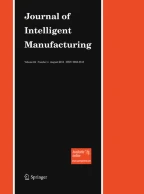Abstract
Tool sequence selection is an important activity in process-planning for milling and has great bearing on the cost of machining. Currently, it is accomplished manually without consideration of cost factors a priori. Typically, a large tool is selected to quickly generate the rough shape and a smaller clearing tool is used to generate the net-shape. In this paper, we present a new systematic method to select the optimal sequence of tool(s), to machine a 2.5-axis pocket given pocket geometry, a database of cutting tools, cutting parameters, and tool holder geometry. Algorithms have been developed to calculate the geometric constructs such as accessible areas, and pocket decomposition, while considering tool holders. A Genetic Algorithm (GA) formulation is used to find the optimal tool sequence. Two types of selection mechanisms namely “Elitist selection” and “Roulette method” are tested. It is found that the Elitist method converges much faster than the Roulette method. The proposed method is compared to a shortest-path graph formulation that was developed previously by the authors. It is found that the GA formulation generates near optimal solutions while reducing computation by up to 30% as compared to the graph formulation.
Similar content being viewed by others
References
Ahn S., Sundararajan V., Smith C., Kannan B., D’Souza R., Sun G. et al (2001) CyberCut: An Internet based cad/cam system. Journal of Computing and Information Science in Engineering 1(1): 52–59
Al-Hakim L. (2001) An analogue genetic algorithm for solving job shop scheduling problems. International Journal of Production Research 39: 1537–1548
Bala M., Chang T.C. (1991) Automatic cutter selection and optimal cutter path generation for prismatic parts. International Journal of Production Research 29(11): 2163–2176
Balasubramaniam M., Joshi Y., Engels E., Sarma S., Shaikh Z. (2001) Tool selection in three-axis rough machining. International Journal of Production Research 39(18): 4215–4238
CNC Software, Inc. (2006). Mastercam x, Mastercam x Quick Reference Guide.
Cormen T., Leiserson C.E., Rivest R.L. (1990) Introduction to algorithms. MIT Press, Cambridge, MA
D’Souza R., Wright P.K., Séquin C. (2001) Automated microplanning for 2.5-D pocket machining. Journal of Manufacturing Systems 20(4): 288–296
D’Souza R., Wright P.K., Séquin C. (2002) Handling tool holder collision in optimal tool sequence selection for 2.5-D pocket machining. Journal of Computing and Information Science in Engineering 2(4): 345–349
De Jong, K. A. (1975). An analysis of the behavior of a class of genetic adaptive systems. Doctoral Dissertation, University of Michigan.
Glenn, C. (2000). A closer look at toolpath strategies, MMS Online, Featured Articles, Surfware, Inc.
Goldberg D.E. (1989) Genetic algorithms in search, optimization and machine learning. Addison-Wesley, Boston, MA
Homaifar A., Guan S., Liepins G.E. (1992) Schema analysis of the traveling salesman problem using genetic algorithms. Complex Systems 6(2): 183–217
Lee Y.S., Chang T.C. (1994) Using virtual boundaries for the planning and machining of protrusion freeform features. Computers in Industry 25(2): 173–187
Lee Y.S., Chang T.C. (1995) Application of computational geometry in optimizing 2.5d and 3d nc surface machining. Computers in Industry 26(1): 41–59
Lee Y.S., Daftari D. (1996) Feature-composition approach to planning and machining of generic virtual pockets. Computers in Industry 31: 99–129
Lim T., Corney J., Ritchie J.M., Clark D.E.R. (2001) Optimising tool selection. International Journal of Production Research 39(6): 1239–1256
Rai R., Kameswaran S., Tiwari M.K. (1999) Machine-tool selection and operation allocation in FMS: Solving a fuzzy goal programming model using Genetic algorithm. International Journal of Production Research 40(3): 641–665
Rajeev S., Krishnamoorthy C.S. (1992) Discrete optimization of structures using genetic algorithms. Journals of Structural Engineering 118(5): 1233–1250
Spatial Technology. (1994). ACIS geometric modeler, API Reference.
Türkay D., Filiz H. (1999) Optimisation of process planning functions by genetic algorithms. Computers and Industrial Engineering 36: 281–308
Veeramani D., Gau Y. (2000) Cutter-path generation using multiple cutting-tool sizes for 2-1/2D pocket machining. IIE Transactions 32: 661–675
Whitley, D. (2007). A genetic algorithm tutorial. Computer Science Department, Colorado State University.
Yang D.C.H., Han Z. (1999) Interference detection and optimal tool selection in 3-axis nc machining of free-form surfaces. Computer Aided Design 31: 305–315
Yao, Z., Gupta, S., & Nau, D. (2001). A geometric algorithm for selecting optimal set of cutters for multi-part milling. In Proceedings of the Sixth ACM Symposium on Solid Modeling and Applications (pp. 130–139).
Yao Z., Gupta S., Nau D. (2003) Algorithms for selecting cutters in multi-part milling problems. Computer-Aided Design 35(9): 825–839
Zhou H., Feng Y., Han L. (2001) The hybrid heuristic genetic algorithm for job shop scheduling. Computers and Industrial Engineering 40: 191–200
Author information
Authors and Affiliations
Corresponding author
Rights and permissions
About this article
Cite this article
Ahmad, Z., Rahmani, K. & D’Souza, R.M. Applications of genetic algorithms in process planning: tool sequence selection for 2.5-axis pocket machining. J Intell Manuf 21, 461–470 (2010). https://doi.org/10.1007/s10845-008-0201-6
Received:
Accepted:
Published:
Issue Date:
DOI: https://doi.org/10.1007/s10845-008-0201-6
